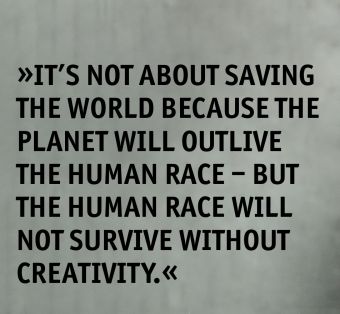
It’s not about saving the world!
Cultural Manager, Creative Industries Expert and Design Aficionado

IT'S NOT ABOUT SAVING THE WORLD!
Renaissance is a word that you could associate with many things, on different levels and in various disciplines. If the concept of a “New European Renaissance in the Making” is to be discussed comprehensively at this point, then we should nevertheless keep in mind relevant historical landmarks and, to an even greater extent, the humanistic and social impact of the Renaissance, simply because we should be aware of the consequences. Accordingly, what could be subsumed under that term—despite all of its varied manifestations as Renaissance, Humanism or Reformation—is the concept of radical change, of a paradigm shift. We shall talk about that below when Creative Industries shift into the focus.
In recent decades, the need for change—you could also call it a restart or a reset—has become increasingly virulent and perceptible, especially in the creative sector and, above all, in the field of design. What had initially begun as a rather vague feeling of uneasiness is now becoming a visible constant in societal discourse. Behind it is the vast transformation of society and media which has caused radical change to our living and working environments. In order to present evidence for those transformations, you do not necessarily need to mention an epochal happening like a pandemic, although the pandemic has certainly sharpened our perspective on those upheavals. In that respect, then, there is no better time than now to address the “New European Renaissance in the Making”. And creativity will play a crucial role in it.
the human race will not survive without creativity
The idea is as simple as it is provocative: It’s not about saving the world because the planet will outlive the human race—but the human race will not survive without creativity. Now, at this point we could maintain that things have always been that way, and that is, of course, correct. There is, however, one fundamental difference: Today, in the 21st century, we are aware of the situation. It is no longer about mere inventions that could make something easier, faster or bigger, but rather about avoiding man’s extinction. That may sound somewhat pessimistic, but a glance at today’s state of the world (climate change, a migration crisis, and so on) seems to justify this dramatic momentum. In view of that, many people, above all younger people, are no longer prepared to uncritically perpetuate the quasi-natural mechanisms of life and work. Hence, the above-mentioned change can only happen through us and it will only succeed if we—which at first glance seems to be a paradox—do not put man, the individual person, at the centre of considerations.
To that end, we are in need of design, but the kind of design that can shoulder the current challenges. Over the past 150 years, design has taken on growing social responsibility as a key player in the developments of industrial society. If design had previously been perceived as a predominantly aesthetic and visual amenity serving the financial success and profit maximisation of big business, towards the end of the 20th century it started to become a tool for human needs that accounted for the capabilities and behaviour patterns of individual users. So-called user-centred design was suddenly in the limelight, triggering a process of unprecedented individualisation and commercialisation that completely disregarded the political and societal dimensions of design. However, that met with prompt criticism. As early as 1971, Victor Papanek in his book Design for the Real World criticised the trend towards producing “increasingly useless, potentially harmful, irresponsible and—from an ecological viewpoint—questionable items of mass consumption.” He spoke out against irresponsible design and developed a radio for the Third World based on an old tin can.
The answer to the question as to whether the time is ripe for revolution is, unequivocably, Yes
Fifty years on, Papanek’s approaches are meeting with increasing approval. Many designers are no longer prepared to pander to the demands of wealthy clients with aesthetically exalted tastes, but are instead beginning to question their role in the context of a widening schism between rich and poor and in the light of environmental problems. They participate in social movements, support grassroots initiatives and try to contribute to improving the world in a simple and quite unobtrusive way. This development marks a distinct turning point in the discourse on design, reflecting new standards that will determine how we shape our environment. A fundamentally different way of thinking is born: In place of nurturing individualism to the point of perversion, a genuine search has started for meaningful creative activities that focus on the bigger picture to deliver the best solution for man, society and nature. This approach to design will revolutionise future creativity and the future of creativity. It is about society-centred design that not only caters to users or to economic considerations, but above all to society and our environment.
The answer to the question as to whether the time is ripe for revolution is, unequivocably, Yes. It is high time and we can prove that by the fact that this attitude towards design has already arrived on the economic level. Businesses are experiencing a growing client demand for products and services that do not necessarily have to offer “more” (faster, further, bigger, more expensive), but should be fundamentally “different”. Those enterprises realise that they could have a competitive advantage if they pursue that strategy, which means that one of the toughest barriers for the widespread acceptance of society-centred design has been overcome.
Of course, that does not exempt us as representatives of Creative Industries—who often negotiate the topic on a highly theoretical level—from the responsibility of actively promoting this approach and introducing it with greater vehemence to enterprises. From the very start, we must rule out any suspicion that the matter could again end up in self-referencing ritualised academic discourse enriched with theoretical considerations on university level without, however, yielding any practical effects. The order of the day is, therefore, to act now and to implement the developed concepts at once. We know from experience that there is no lack of ideas, but rather a certain hesitance to implement them.
creativity as a maxim for future actions
Creativity and Creative Industries play a crucial part in that respect because they often allow unexpected solutions to unfold. Human creativity therefore makes the big difference, and again, it is not just about intelligence that could be made by a machine. There is no doubt that artificial intelligence will have an enormous impact on our future life. Creativity, however, is a profoundly human phenomenon that we should maintain at all costs. But precisely because is associated with a quantum of uncertainty, creativity—acting creatively—is rarely planable in a strict sense. We therefore have a dilemma. Creativity cannot be practiced to produce a solution, like an athlete training for a competition. For that reason, we are required not only to allow creativity to flourish on all levels, but also to actively promote it. Essentially, it is about augmenting the potential for creativity to a maximum and letting it permeate all areas right to the finest ramifications and niches of life. Maybe the solution for one of many challenges will originate from there. At the same time, it is a procedure of trial and error as well as creatio ex nihilo. The latter, i.e. creation out of nothing which is known from early Christian cosmogony, also found its way into modern physics: Stephen Hawking, too, argued that the Universe could have been created out of nothing—thus illustrating the principles of creative work. That would not only explain creativeness most aptly—it would also restore creativity to our lives as a maxim for future actions.
Eberhard Schrempf
Cultural Manager, Creative Industries Expert and Design Aficionado in Austria
Eberhard was vice-artistic director and managing director of the European Capital of Culture – GRAZ 2003 and is the director of the „Creative Industries Styria“ network since 2007. In this function, he developed the festival „Design Month Graz“ and was responsible for the successful application of the city of Graz to become a UNESCO City of Design, as well as developing many innovative projects and formats. Schrempf advises numerous companies and institutions in the areas of creativity, design and management. He is lecturing at the Institute for Design and Communication at the FH Joanneum, University for applied sciences, a lateral thinker and guest speaker at international conferences.
Picture: © Raneburger

